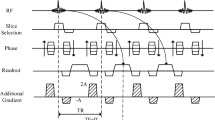Abstract
Ultrasound hyperthermia is one of the most important methods in tumor treatment and characterized by non-invasiveness. Magnetic resonance imaging (MRI)-based temperature mapping techniques are safe compared with invasive methods and have been applied to detect temperature changes for a variety of applications. Among these techniques, the proton resonance frequency (PRF) method is relatively advanced. With a temperature measuring experiment, the effectiveness of PRF method has been proved, because the outcome temperature curve and the real temperature curve fit well. After that, an experiment has been conducted on tumors inside rabbit legs and the result indicates that this system is able to performance hyperthermia at targets based on PRF method in temperature mapping.
Similar content being viewed by others
References
Shi Bing-yi, Yan Ying. Tumor thermotherapy [J]. Progress in Japanese Medicine, 1986, 7(7): 324–325 (in Chinese).
Ke Wen-tan, Chen An-min. The use of thermotherapy in the treatment of malignant tumors [J]. Contemporary Medicine, 1997, 3(3): 168–173 (in Chinese).
Gail R. High intensity focused ultrasound for the treatment of tumors [J]. Echocardiography, 2001, 18(4): 317–322.
Quesson B, Zwart D, Christ T W. Magnetic resonance temperature imaging for guidance of thermotherapy [J]. Journal of Magnetic Resonance Imaging, 2000, 12(2): 525–533.
Sukhoon O, Andrew G W, Thomas N, et al. Experimental and numerical assessment of MRI-induced temperature change and SAR distributions in phantoms and in vivo [J]. Magnetic Resonance in Medicine, 2010, 63(1): 218–223.
Yang Bo, Shen Guo-feng, Chen Sheng, et al. Development of embedded ultrasound tumor hyperthermia instrument [J]. Chinese Journal of Medical Instrumentation, 2013, 37(2): 88–91 (in Chinese).
Robert T, Markus S. Measuring temperature using MRI: A powerful and versatile technique [J]. Magnetic Resonance Materials in Physics, Biology and Medicine, 2012, 25(1): 1–3.
Ren Guo-xin. Preclinical and clinical application for tumor local hyperthermia equipment [D]. Shanghai: Med-X Research Institute, Shanghai Jiao Tong University, 2006.
Author information
Authors and Affiliations
Corresponding author
Additional information
Foundation item: the National Natural Science Foundation of China (No. 30800246), the Shanghai Key Technologies R&D Program of China (No. 09441900500) and the Research Program of Shanghai Education Commission (No. 14CXY05)
Rights and permissions
About this article
Cite this article
Zhu, My., Shen, Gf., Su, Zq. et al. Real-time MRI-controlled ultrasound hyperthermia system for superficial tumor treatment. J. Shanghai Jiaotong Univ. (Sci.) 19, 715–717 (2014). https://doi.org/10.1007/s12204-014-1572-9
Received:
Published:
Issue Date:
DOI: https://doi.org/10.1007/s12204-014-1572-9




